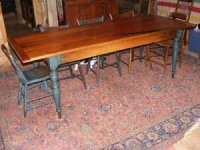Peter H. Wallace
Member
I am going to be making a Harvest table with a curly cherry top and a maple painted undercarriage for a client. They want the curly cherry top to be made from 6/4 stock, three boards across with bread board ends. My concern is the weight of the table and corresponding leg diameters to support the top without movement. Is there a way to determine the smallest diameter of the legs which will keep the table from moving/flexing? In the past, I have made these table with 3/4" tops supported by turned legs with the smallest diameter being one inch thick. This was always a very stable table. However, with a thicker top made from 6/4 stock, mesuring 44" x 84" I am concerned about stability? Ideas or suggestions welcomed.
Pete
Pete

